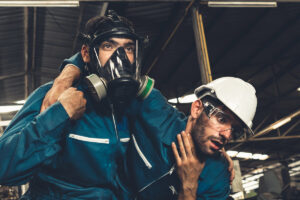Potentially Deadly Substances Can Be Inhaled in the Workplace | Industries Where Toxic Fumes Commonly Pose Health Risks
 When most people think about work-related injuries, they envision broken bones, back or neck injuries, burns, lifting injuries, repetitive stress, and other trauma to limbs, digits, and organs. Over the past decade, though, the number of workplace injuries and deaths caused by toxic fumes has increased dramatically. Recognizing the dangers posed to workers, the Occupational Safety and Health Administration (OSHA) has enacted rules and regulations setting permissible exposure limits and mandating worker training. What are the most common substances that emit toxic fumes? Which industries commonly expose workers to such fumes?
When most people think about work-related injuries, they envision broken bones, back or neck injuries, burns, lifting injuries, repetitive stress, and other trauma to limbs, digits, and organs. Over the past decade, though, the number of workplace injuries and deaths caused by toxic fumes has increased dramatically. Recognizing the dangers posed to workers, the Occupational Safety and Health Administration (OSHA) has enacted rules and regulations setting permissible exposure limits and mandating worker training. What are the most common substances that emit toxic fumes? Which industries commonly expose workers to such fumes?
What Common Materials Can Produce Toxic Fumes?
The substances that provide the greatest risk to workers are:
- Carbon monoxide (CO)—An odorless and colorless gas, this substance is well-known, as it is emitted as a byproduct whenever fossil fuels are burned. Motor vehicles and other heavy equipment and machinery that operate on gas all generate carbon monoxide. Because it has no smell and is invisible, it can be present and cause injury before workers can take any precautions.
- Ammonia—Though ammonia is also invisible to the naked eye, it has a strong and distinct smell, making it easier for workers and supervisors to detect it and take measures to avoid injury. When diluted, it poses minimal risk, but a higher concentration can cause burning of the skin, as well as the lungs (if inhaled).
- Chlorine and chlorine gas—Chlorine is a basic element often used in household cleaners and other products. It can also take the form of a gas and can be highly poisonous when it does. In its liquid form, chlorine turns to a gas when exposed to the atmosphere. Because it’s heavier than air, it tends to cling to the ground. Chlorine gas has a distinctive smell… it’s what you smell most in laundry bleach. When it converts to a gas, it becomes yellow-green in color.
- Paint fumes—Paint contains a number of substances that can release fumes into the air, including:
- Xylene—A chemical that can cause external irritation, as well as vertigo, confusion, loss of muscle control, and even death.
- Benzene—A chemical that vaporizes rapidly into a heavier-than-air gas that can cause heart problems, loss of motor control, and death.
- Toluene—A colorless liquid that converts to a gas at room temperature and causes damage to the nervous system, if inhaled.
- Trichloroethylene—Commonly used in industrial applications, this substance produces a gas that can damage the lungs and cause cancer.
- Acetone—Typically found in industries as a solvent, this toxic gas causes heart, lung, and other internal injuries.
Industries Most Likely to Expose Workers to Toxic Fumes
Carbon monoxide poses a widespread danger of toxic fume inhalation, affecting workers in a wide range of industries, including:
- Mechanics, firefighters, longshore workers, forklift operators, toll-booth operators, and others around motor vehicles;
- Warehouse workers in industries using propane or diesel forklifts;
- Restaurant workers, particularly where there are indoor open flames; and
- Workers at coffee processing facilities, where beans are roasted.
Workers in fertilizer production, as well as large-scale agriculture, can be at risk of ammonia poisoning. In addition, any industry that uses refrigeration (particularly food production) can pose a threat of ammonia inhalation.
Chlorine and chlorine gas exposure is most often found in industries involved in the production of cleaning products and solvents, such as household bleach and soaps. It’s also a risk in paper and cloth manufacturing facilities.
Paint fumes can pose a risk in almost any type of business or industry, from architectural and automotive to marine and industrial wood production (the manufacture of laminates, fiberboards, and similar products).
Contact InjuredCare.com to Connect with an Experienced Health Professional
To get connected with the right health professional, contact us online or call our offices today at 866-952-7045.

